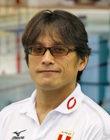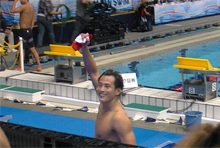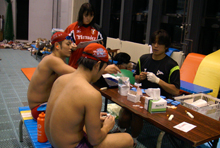Top>Education>Taking on all possibilities: Chuo-style athlete training methods
 Index
Index

Toru Moriya [Profile]
Taking on all possibilities: Chuo-style athlete training methods
Toru Moriya
Associate Professor of Competitive Swimming Training Science, Faculty of Commerce, Chuo University
Make dramatic progress and then head to the Olympics

Chiaki Ishibashi, who made great leaps at the All-Japan Swimming Championships, which doubled as a qualifier for the London Olympic Games
At the 88th All-Japan Swimming Championships held at Tokyo Tatsumi International Swimming Center the other day, Chiaki Ishibashi (3rd year student, Faculty of Policy Studies), who I am in charge of coaching, competed in the 200m freestyle event and made a huge leap from last year's ranking of 12th, finishing in 4th place, brilliantly sealing his place on the team for the London Olympic Games. So far, Chuo University swimming team has produced many top-class swimmers with the ability to compete on the international stage. Furthermore, in the past 18 years at the student championships, where the battle to be called number one in Japan is fought, we have succeeded in taking out the overall title 13 times. Our team is one of the few swimming teams that focus on being active at university. In relation to that, I would like to add, in conditions that many university swimming teams are allowed to practice in public swimming clubs, all our swimming team members conduct their training at Chuo University.
The man who oversaw the swimming team's evolution to number one in Japan was current swimming coach, Professor Yusuke Takahashi, Faculty of Science and Engineering, and furthermore, the achievements of former coach, Professor Yutaka Yoshimura, Faculty of Science and Engineering, who put a lot of work into university swimming, and introduced team-building and training methods which can be said to be revolutionary, raising results, can not be overlooked. In this essay, from a comparatively close distance as coach and position of coming face-to-face with this university's swimmers, I would like to introduce parts of how we improve competitive skills in university.
Characteristics and trials of competitive swimming
Originally, swimming isn't a physical movement that is closely related to lifestyle, and there are many elements where improvements to swimming only have been made. No matter how excellent one's physical attributes are, because the medium, water, is fluid, propelling strength is not totally consisted of the strength that is exerted. It can be said that swimming is an extremely technical exercise because swimmers perceive pressure from the palms and bottom of the feet and speed of water flowing around the skin, and slight output adjustments and movements are controlled in order to swim at an intended speed. For that reason, compared to other sports, a lot of time is required for specialist training. On this point, for university students who have enhanced their physical characteristics to the utmost limit in their high school and possess high competitive strength, along with raising flexibility by various speed training, there is a need to develop various drills with the aim of improving movement and coordination skills. As a result, the training times for top-level university students are extensive. In the case of our swimming team, a total distance about 60-80,000 metres and 30 hours is spent in the water almost every week.
A few activities that are possible because the learners are university students
In response to this severe training, I provide coaching that entices independent activities. Therefore, in addition to giving technical guidance and making workout menu, what I endeavor not to leave out are, 1)close communication with each individual competitor, 2)secure classroom lecture time necessary for conducting effective training, and 3)conducting scientific measurements in training.
In regards to 1, I especially attach importance to the individual meetings held at training. Before holding these meetings, I ensure that the swimmers themselves have taken an appropriate look back, and on top of that, make clear the goals in the next step. Furthermore, in order to achieve those goals, I make them investigate the necessary effort methods, and in order to implement those, I give them opportunities to think hard about the necessary mental preparedness. When that step is completed, in the individual meetings with me, I guide them to think even deeper in relation to methods of effort needed for the above mentioned "looking back" and accomplishing goals.
In regards to 2) classroom lectures, lectures using presentation software and visual materials are taking place in the training program on a planned or systematical basis. Here, as well as the obvious provision of information relating to training plans and swimming skills, the basis for severe training, the basis for introducing low-intensity training, the significance of land training, nutritional knowledge for raising training results, and furthermore, functional anatomy, in order to prevent injuries, is taught. That is, it can be said that it is creating opportunities to cultivate the positive learning attitude required for understanding in order to raise one's own competitive strength.

Blood lactate density measurement
There is also the opportunity that students can practically learn some of what they studied in the classroom lecture through exercise physiological support. That is a scientific test called the Lactate Curve Test. In this test, swimming speed corresponding to OBLA (Onset of Blood Lactate Accumulation) is derived from the relation between swimming speed and blood lactate density. OBLA, as an indicator showing endurance exercise tolerance, is a measured value supported internationally, and the swimming speed when OBLA appears can be used as an evaluation of swimming ability including technique. After taking this test periodically once every 4-6 weeks, the swimming speed-blood lactate relationship is plotted on a graph and handed to each swimmer, giving them an opportunity to think about how their swimming ability has changed through training.
In the ways mentioned above, training at our university isn't just to make them work hard, but by providing scientific information, we put everything into strengthening an attitude of hoping, planning and putting effort from oneself. I believe that this Chuo-style coaching is, exerts a positive influence on students these days who have a strong tendency of not trying for any reason.
Coaching for university students
Even in highly motivated students, in their daily training they come across days when they feel they are performing poorly, days when they feel physically weak, and even days when they don't feel up to it. On these kinds of days, it is easy to form thoughts of "I'll take it easy" at training. There are even times when one will swim with a technique that is a rule violation (one-handed turns etc.). It may be a trivial matter, but if you overlook this, regardless if you realize it as being bad, you place priority on escaping the hard work, planting the seeds of incorrect habits. If left untouched, kinks could be produced in sport activity where rules should be kept and correct methods are instilled. For that reason, I always try to look out for that kind of behaviour.
In regards to this point, because a strict warning will only lead to thoughts of "I'll make sure I don't get caught next time", I have a thorough talk into why that behaviour needed warning against. On the other hand, when praising somebody, I put effort into having them understand why they are being praised.
Recent students have a low tolerance of being scolded, and I also feel that there is a certain type that acts in a manner as not to be scolded. They appear serious at first glance, the so-called good kid, but there are many who are thin-skinned on the other hand, and wither in pressure situations. In regards to students who possess those characteristics, by simply applying warning only or praise only coaching, there is a high possibility that they will take a serious look at devising ways "not to be scolded next time", or "to get more praise", before the true cause can be considered. As a result, when they confront difficulties, it becomes difficult to nurture skills for accumulating study about those coping methods, and skills for persistent action.
On the other hand, after entering this university, for students who have been raised to understand the reasons why they are being scolded or praised, and can make way for something at their own will, when they sometimes show symptoms of escaping in future training, even if I use total scolding coaching to point out it, there are many cases where the student accept it and can use it as a reason to make improvements.
Continuing to challenge possibilities

Chuo University swimming team training
When the strict training is overcome and targets are achieved, the swimmers are filled with a feeling of satisfaction that can not be described. However, there are times when they don't succeed. On this point, if it is a person who continued to battle on their own will, and pursued effort methods, even if they didn't achieve their goals, they will have a refreshing feeling. In achieving their goals, how many challenges did they go through.? It can be said that our swimming team is taking up the challenge to a field that is difficult to be achieved by physical education and sports activities which are forced to do.
I believe that the special characteristic of university students is, not only at home and their instructors, they accept influences from gradual changes in the background of their era, and continue those changes. Even so, more than working in a job that supports their sporting activities, I am hoping that they will challenge possibilities. For that reason, I want to continue enforcing Chuo-style coaching and see the sparkle in students possessing a variety of personalities.
- Toru Moriya
Associate Professor of Competitive Swimming Training Science, Faculty of Commerce, Chuo University - Born in Tokyo.
Graduated from the Law Department at Chuo University's Faculty of Law in 1990. Completed his Master's degree in Health and Physical Education from Tokyo Gakugei University Graduate School of Teacher Education in 1993.
Started current position in 2007 after spending time as full-time lecturer and assistant professor in the Faculty of Commerce, Chuo University.
Official advanced coach, Japan Swimming Federation
Swimming strengthening staff, Japan Swimming Federation
Coach for Japan's national team, 2009 Universiade, Belgrade
Coach for Japan's national team, 2011 Universiade, Shenzen
His current line of research is training programming for competitive swimmers with the aim of improving competitive strength, and competitive swimmer training programs in low oxygen environments. - Chuo University Swimming Team training blog http://maraduer.blogspot.jp/

- Research Activities as a Member of Research Fellowship for Young Scientists (DC1), Japan Society for the Promotion of Science (JSPS) Shuma Tsurumi
- Important Factors for Innovation in Payment Services Nobuhiko Sugiura
- Beyond the Concepts of Fellow Citizens and Foreigners— To Achieve SDGs Goal 10 “Reduce Inequality Within and Among Countries” Rika Lee
- Diary of Struggles in Cambodia Fumie Fukuoka
- How Can We Measure Learning Ability?
—Analysis of a Competency Self-Assessment Questionnaire— Yu Saito / Yoko Neha - The Making of the Movie Kirakira Megane








